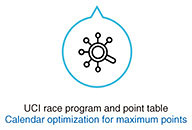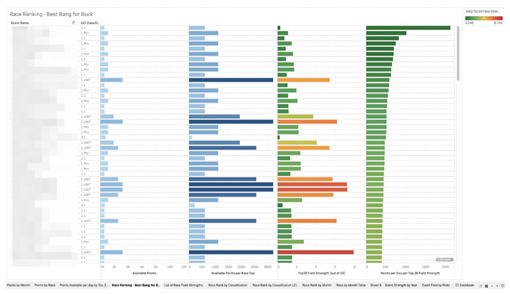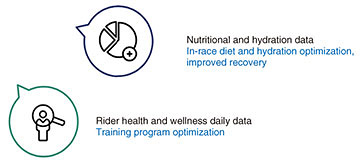 |
|
|
|
|
|
Feature Articles: Global Business Initiatives Vol. 18, No. 12, pp. 31–38, Dec. 2020. https://doi.org/10.53829/ntr202012fa4 NTT Pro Cycling: Data-driven Innovation in ActionAbstractWith thousands of riders and hundreds of races to choose from each year, the NTT Pro Cycling team uses data and advanced analytics to optimize their performance by ensuring they recruit the best possible riders for their budget and for selected races. Training is then optimized for every individual rider to ensure they are in peak condition for their target races, giving them the best chance to maximize UCI (Union Cycliste Internationale) points. NTT Ltd. supports the team through innovative technology that monitors and manages the performance of the riders. We also use advanced data analytics and data science to help the team make key decisions. Working together within a support ecosystem, we give the team every possible advantage to be a high-performing pro sports team, both on and off the bike. Keywords: data analytics, technology, NTT Pro Cycling 1. The NTT Pro Cycling team and its missionIn the world of professional cycling, NTT Pro Cycling is unique. It is the first team with roots in Africa competing on the world stage and that is riding to uplift communities in Africa through their support of the Qhubeka charity. Qhubeka is an African not-for-profit organization that donates bicycles as part of the World Bicycle Relief’s charity program and has supplied more than 75,000 bicycles through fundraising programs targeted at children in rural African communities to make it easier for them to get to and from school, helping to improve their attendance and performance. The team strives to be the benchmark within the sport through being a performance-driven, technology-enabled team underpinned by their unique purpose-led approach in their support of the Qhubeka charity. Their commitment to changing lives together with Qhubeka remains stronger than ever, and they will be looking to do so with even greater enthusiasm in the years to come. Together with staff, riders, and valued partners, this core belief remains a foundation of the team. This truly is a team that was born in Africa but created for the world. As the NTT Pro Cycling team’s technology innovation partner, NTT Ltd. helps the team to be the most purpose-led, performance-driven, and technology-enabled team in pro cycling today. We work together to fulfill their ambition of being ranked among the top 10 cycling teams in the world. Racing in the Union Cycliste Internationale (UCI) World Tour, the premier men’s elite road cycling tour, means competing against some of the best funded teams in the most iconic cycling races. To achieve this, the team leverages the power of advanced data analytics and data platforms. This enables them to harness all their resources in the best possible way, based on real data, to perform at the highest level possible to win as many points as possible, retaining World Tour status and delivering value for their sponsors who provide their primary revenue stream. 2. Creating a technology-enabled data-driven pro-cycling teamIn 2020, the team adopted a fully integrated athlete performance management solution for training analysis, health and wellness tracking, in-race hydration and nutrition management, injury reporting, and overall athlete condition (health and mental wellness) monitoring. Additionally, advanced data analytics help the team with regards to talent recruitment and retention as well as establishing a race calendar and team selection to maximize the potential UCI points and race results (Fig. 1).
The team uses data science to drive key decision-making to meet the following three critical performance criteria:
NTT Ltd. provides several technologies and services to help NTT Pro Cycling meet these performance criteria. These technologies cut across advanced data analytics, data platform, hybrid cloud, and artificial intelligence and machine learning. We provide a range of services in support of these technologies to address the team’s performance criteria including:
Over the past year and a half, NTT Pro Cycling, in conjunction with NTT Ltd., has been working on a comprehensive data platform that helps the team climb the UCI rankings. The solution supports the team through innovative technology focused on advanced data science, which is used to help make key decisions faster. Innovative technology not only supports NTT Pro Cycling’s performance but also its business processes. Data analytics help the team select riders, prepare the race calendar, and assign the right riders to the right races. Such technology also helps the team monitor the health of its riders by tracking physiological data through a health and wellness application. To compete at the top of cycling’s World Tour, the team is looking to drastically improve and force its way into the top 10 of the World Tour team ranking. The team is challenging themselves to be better. They leverage innovation, technology, and data in new ways to enhance their performance daily and speed up and improve decision making. Like all other organizations, professional sports teams have embarked on a digital transformation journey to remain relevant and competitive. It is only through this that they improve their efficiencies and become more effective organizations. For NTT Pro Cycling, this is no different. 3. Rider recruitmentEvery pro cycling team knows their riders are their most important assets. Having the right riders with a range of skills and capabilities is an important foundation for building a successful cycling team and to secure those all-important race victories. NTT Pro Cycling uses data to analyze just about every pro cyclist in the world. Using a combination of historical data and performance metrics, they can identify which riders they want to recruit. By leveraging data analytics, team management can make more informed decisions to build the best possible team while still staying within budget. Over the past 18 months, NTT Pro Cycling and the NTT Ltd. Advanced Technology Group have jointly developed several statistical and analytical models for classifying different riders to study career trajectories and form. Built upon data from ProCyclingStats.com, the analytics package allows the team to distil every rider down to a matrix of strengths and weaknesses. It is a process that runs daily in NTT Ltd.’s cloud platform, scraping required data, calculating all the key metrics, then encapsulating them into a dashboard that team management can use to analyze different groups of riders, deep-dive into individual rider profiles, and calculate the trajectory of that rider in the future (Fig. 2).
3.1 Building a teamTo give the team the intelligence they need, NTT Ltd.’s advanced data analytics solution analyzed over eight years’ worth of race results and team performances. The application programming interface (API) from the Pro Cycling Stats platform creates a view of the current composition of the team (see Fig. 3 for an example). This is then used to identify the specific strengths and weaknesses within the team across five categories of general, sprint, depth, stability, and mountain (example in Fig. 4).
Starting with this overall understanding of the team’s performance data and metrics, team management can work out which riders work best together. They can then use this to create a ‘team stability’ score. 3.2 Gap analysisOnce the status of the current team is established, team management can identify any gaps the riders need to fill (see Fig. 5). By using the analysis of the global pool of pro cyclists, they can see which riders would deliver the biggest ‘bang for buck.’ In addition to examining the strength of the individual riders against the needs of the team, the data analysis solution incorporates the full pro cycling calendar, including the number of points available and the historic strength of the field. This enables team management to identify opportunities to score the maximum amount of points along with which riders and combinations are most likely to be successful.
3.3 Performance analysisAs well as using analytics to establish which riders are the best in any given situation, NTT Pro Cycling uses them to review the global pool of riders. The team understands that discovering the right resources at the right time is critical to success both in business and on the road. With their understanding of the team’s requirements, team management and performance coaches work together to narrow down the thousands of cyclists, creating a shortlist of potential talent. Factors taken into consideration include rider type, race victories, age, and recent performance, to name a few. From that information, the analytics package’s algorithm deducts the likelihood of riders earning ever-important World Tour points in races to come, i.e., the ‘win quotient.’ Together with data-driven rider profiles, management has a view of each rider’s strengths and weaknesses, allowing them to identify the skills needed to fill the gaps. 3.4 Integrate, monitor, and reportThe final phase is actual recruitment. With a holistic view of the current team, the gaps they need to fill, and the potential talent available from our data and analytics solution, team management are able to make quicker, more informed decisions, taking some of the guesswork out of the process. These tools allow decision-makers to make objective choices to help them achieve their goals. All this information allows team management to sign riders and be assured that, together with their vast industry knowledge and experience, technology will enable them to improve their performance. To monitor and evaluate performance, NTT Ltd. has integrated multiple technologies, wearables, Internet-of-Things devices, platforms, and tools to provide both detailed performance analytics and a holistic snapshot for management. One final note on rider recruitment. NTT Ltd.’s solution allows the team to look beyond the big names, to the true ‘moneyball’ performers, i.e., the riders who have previously been overlooked but provide a unique value proposition. Using a combination of historical data and performance metrics, experienced sports directors can supplement the process by identifying riders for specific roles to help fill out the roster. 4. Data-driven calendar optimizationIn addition to the 36 compulsory World Tour events, there are hundreds of races for teams to choose from, so making the decision about which races to participate in with which riders is critical to success. For this reason, NTT Pro Cycling uses data analytics to help optimize their race calendar and use their resources most effectively. The team participates in 82 races on 256 days across five continents every year with up to three different races on a single day. This creates not just logistical challenges but challenges in ensuring optimal team performance. To obtain the best possible results, the right riders need to be at the right races at the right time. The logistical issue is that there are 29 riders, 54 management and support staff members, over 200 bicycles, 250 sets of carbon wheels, 22 vehicles, over 900 airplane tickets, 3.5 tons of nutrition, and dozens of partners and assets across the globe. This makes up the complex team infrastructure that is NTT Pro Cycling. As part of NTT Pro Cycling’s drive to secure World Tour points, the team must make tough decisions about which races to participate in. The calendar needs to create a balance among logistical feasibility, the opportunity to earn points, rider schedules, their strengths, and their training and race load (Fig. 6).
At the top level of cycling—the UCI World Tour—securing enough points is critical to the team’s survival. With different tiers of races and different point scales, it is essential to know where the best opportunities to score points are. Data and analytics tools help the team identify this and from that, build a race calendar. The team uses an algorithm to take into account the points available by race, calculate field strengths based on the caliber of riders who have competed in the past, and create a points-per-race-day weighted by the field strength indicator. This shows the best value races where they are likely to achieve the best results, therefore earn the most points. From there, the scoring, together with the logistical constraints of time and distance, helps the team build out the race calendar. Coupled with our rider and team composition analyses, they can pinpoint who should go to which races. The system produces multiple dashboards (see Fig. 7 for an example), which team management can use along with other key information such as rider programs and team logistics, in determining which races they should attend.
One of the main findings from this analysis is that it is four times easier to win points in Asia Tour .HC (now ProTour) races than in European World Tour races. It also shows that the team’s riders can win more points in one-day races than stage races. There are more points on offer at World Tour races, but they are statistically more difficult to earn. The analysis proved its worth early on with strong results across the globe:
5. Rider training, health, and wellnessTraining, preparation, nutrition, and health are key ingredients for any successful pro-cyclist. NTT Pro Cycling understands this as they use a combination of technology solutions from their ecosystem of partners including NTT Ltd., Alcatel Lucent Enterprise, Lumin Sports, Today’s Plan, Garmin, and Rotor, to monitor and optimize the riders training and race preparation. Phila (an Nguni word meaning ‘to live’) is a health and wellness mobile application that provides a morning and evening questionnaire to check on the rider’s location, sleep, fatigue, mood, soreness, illness, injury, training, and race feedback. It allows the coach to provide immediate feedback on the day’s training plans (Fig. 8).
Assisting in optimizing hydration and nutrition for recovery, the team uses the Hydration and Nutrition Guidance (HANG), an automated application for use at races. The app is linked with Bluetooth Smart Scales to capture morning, pre-, and post-race weights to track hydration levels and provide personalized recommendations to each rider following the race. The team uses a centralized athlete data reporting tool called ARC, which integrates all the training data, health and wellness data, HANG data, and race reporting to provide the coaches and team management with performance dashboards on key metrics, including the optimal training load for each rider and race analysis and modelling training load based on rider race schedules. 6. Summary and resultsFor NTT Pro Cycling, innovative and advanced data science is used to help make key decisions faster to not only support the team performance but also their business processes. Data analytics help them select riders, prepare their race calendar, and assign the right riders to the right races. Innovative ecosystem technologies also help them monitor the health of its riders by tracking physiological data through a health and wellness application. It would be naive to think that NTT Pro Cycling is the only team looking at gaps in its line-up and trying to recruit to fill those gaps. It is also unlikely to be the only team with a data analytics solution of some kind to help with the process. However, the team is far ahead of the curve in the road cycling space in the level of sophistication and detail of performance monitoring and management solution to provide access to their capabilities and all the crucial data via one unified data analytics platform. With a holistic view of the current team, the gaps they need to fill, and the potential talent available from the data and analytics solution, team management is able to make quicker more informed decisions, taking some of the guesswork out of the process. Using data-driven recruiting, based on team performance, 2020 NTT Pro Cycling’s selected riders should be expected to deliver 25% more UCI points than the 2019 team did, which would result in them moving up 7 positions in the UCI World ranking. To move into the top 15 cycling teams in the world, they require their top 10 riders to win 25% more points than in 2019. To achieve a top 10 ranking would require double the points they accumulated in 2019. Through optimizing the race calendar alone, there is potential to increase the available points they can win by 20–30%. 6.1 Initial resultsAt the time of the writing of this article (before the Tour de France that began in August), the 2020 racing season had already proven to be very successful, reaping the benefits from a technology-enabled, data-and-performance-driven team. With an increase of 18% more UCI points, a ground-breaking 200% increase in wins and 114% more podiums compared to last year’s results, the solution in place has already proven to be of immense value to the team and its management. When NTT Ltd. built the data and analytics platform, the team committed to use the data, applications, and platforms that are collecting the data, so algorithms can be applied to analyze the data to make accurate data-driven decisions. The key is that they trust the data and monitor the outcomes, adjusting along the way, to refine the solution over time and achieve the goal of becoming a top-10 World Tour cycling team. Trademark notesAll brand, product, and company/organization names that appear in this article are trademarks or registered trademarks of their respective owners.
|









